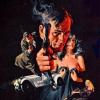Did John Gardner actually write or proof read his later work?
#1

Posted 30 March 2011 - 03:49 PM
For example, in Never Send Flowers there is a gaping error in the story line - When the Mark Fish is shot, "The window fragmented..." but a couple of paragraphs on ""Mark Fish had rolled down his window...." so how could the window fragment if it had been rolled down?
In Death Is Forever, James Bond's ASP pistol is described as a Browning Based pistol when it is Smith adn Wesson (Model 39) based
In Seafire, it is the "Browning ASP" again but the character from The Man From Barbarossa returns with a different name - In Barbarossa he is Pete Natkowitz - In Seafire he is Steve Natkowitz. Interestingly enough, this appears in the UK edition. In the US edition he IS Pete Natkowitz.
Was it only poor proof reading?
#2

Posted 30 March 2011 - 04:15 PM
#3

Posted 30 March 2011 - 05:21 PM
#4

Posted 30 March 2011 - 06:02 PM
For example, in Never Send Flowers there is a gaping error in the story line - When the Mark Fish is shot, "The window fragmented..." but a couple of paragraphs on ""Mark Fish had rolled down his window...." so how could the window fragment if it had been rolled down?
I would not characterize a simple continuity error as a "gaping error in the story line."
Nor do I see how these small, nitpicking mistakes lead you to believe Gardner didn't write the stories.
Fleming is chock full of continuity mistakes, btw.
#5

Posted 30 March 2011 - 06:03 PM
#6

Posted 30 March 2011 - 09:44 PM
#7

Posted 30 March 2011 - 10:04 PM
There's no excuse for poor proofreading.
I can think of dozens.
And, if over the course of fourteen novels there are a couple of minor issues (which may have been an editor/subbie rather than the author) then that's no real dilemma. To leap from that to a suggestion that the author did not write his works is a bit much frankly.
#8

Posted 30 March 2011 - 10:20 PM
#9

Posted 30 March 2011 - 10:22 PM
In Death Is Forever, James Bond's ASP pistol is described as a Browning Based pistol when it is Smith adn Wesson (Model 39) based
In Seafire, it is the "Browning ASP" again but the character from The Man From Barbarossa returns with a different name - In Barbarossa he is Pete Natkowitz - In Seafire he is Steve Natkowitz. Interestingly enough, this appears in the UK edition. In the US edition he IS Pete Natkowitz.
Was it only poor proof reading?
The word "and" in "Smith and Wesson" - please proof-read your work. If you wrote it.
#10

Posted 30 March 2011 - 10:22 PM
There's no excuse for poor proofreading.
I can think of dozens.
And, if over the course of fourteen novels there are a couple of minor issues (which may have been an editor/subbie rather than the author) then that's no real dilemma. To leap from that to a suggestion that the author did not write his works is a bit much frankly.
Good points.
#11

Posted 31 March 2011 - 06:47 AM
In Death Is Forever, James Bond's ASP pistol is described as a Browning Based pistol when it is Smith adn Wesson (Model 39) based
In Seafire, it is the "Browning ASP" again but the character from The Man From Barbarossa returns with a different name - In Barbarossa he is Pete Natkowitz - In Seafire he is Steve Natkowitz. Interestingly enough, this appears in the UK edition. In the US edition he IS Pete Natkowitz.
Was it only poor proof reading?
The word "and" in "Smith and Wesson" - please proof-read your work. If you wrote it.
This may be the finest post the world has ever seen.
#12

Posted 06 April 2011 - 01:02 AM
There's no excuse for poor proofreading.
Don't blame the proof-readers. Amongst a number of books, a few years ago I proof-read a book about Pinewood Studios, pieces that I had "corrected" were ignored and appeared in the published book in their uncorrected state.
#13

Posted 07 July 2011 - 07:43 PM
[/quote]
Totally agree with this comment. I can assure you my Father wrote and proof read all is work. The fact of the matter was that at times
for whatever reason (and we never found out the reasons) corrections that had been marked to be made never happened.
It seems this occurs on a regular basis with any industry that involves more than one person writing and editing 'content'.
When I worked as a book jacket designer in the 1980's/1990's I witnessed the wrong blurb being given to the wrong jacket
on many occasions. Most of the time we caught this but there were times we missed it and paperbacks went out into the market with totally the wrong
information on them. Right title, wrong storyline on the back.
SRJG
#14

Posted 07 July 2011 - 08:36 PM
Also, I'm delighted to see your father's 007 novels being reprinted this year.
Don't anybody bother holding your breath, expecting these editions to contain corrections - I expect they will be printed from previously-existing proofs.
As for books 6-14, will the cover art be the same as the original Hodder & Stoughton editions? I wasn't too impressed with some of them.
#15

Posted 11 July 2011 - 03:07 PM
[/quote]
As far as I am aware ORION/SWORDFISH are only printing the first five JG Bonds in hardback. These as you probably are aware have the original J. Cape jackets.
All of the continuation novels will be published in the UK in paperback starting in 2012. The paperbacks will have brand new artwork. The US Pegasus re-prints have yet to be finalised regarding publication dates and jacket artwork.
SRJG
#16

Posted 24 March 2012 - 07:28 PM
“Montgomery was a stickler for accuracy, and this did not always go down well with authors. Reviewing John Gardner's Madrigal, Montgomery referred to `errors [...] abundantly in evidence'. Gardner wrote asking for clarification. By this time Montgomery had lent his copy to a friend and had to make his points from memory. Even so, he managed eighteen errors (mostly concerned with French and German spelling and accents, and Ben Johnson spelled as Johnson), `and I think it fair to say that if I went through the book I could more than double it. [...] I did feel, however, that since your book makes rather a point of knowledgeability, the mistakes in it were far too numerous.' Gardner was not placated, claiming that these were typographical errors which had not been corrected from his galley proofs, and should have been stated as such.”






